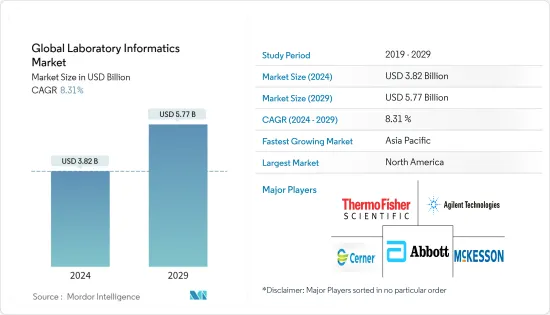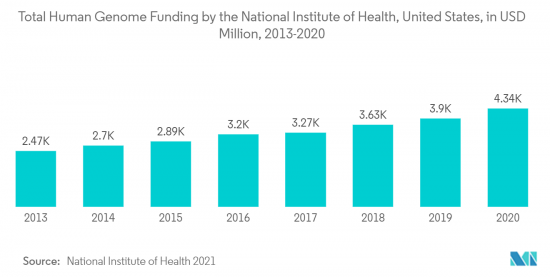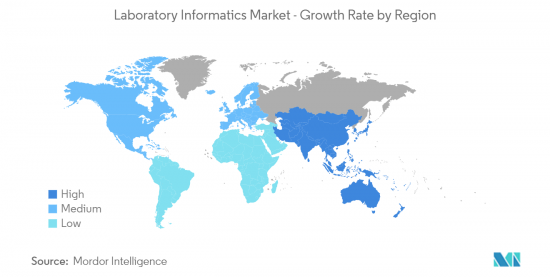PUBLISHER: Mordor Intelligence | PRODUCT CODE: 1430563

PUBLISHER: Mordor Intelligence | PRODUCT CODE: 1430563
Global Laboratory Informatics - Market Share Analysis, Industry Trends & Statistics, Growth Forecasts (2024 - 2029)
The Global Laboratory Informatics Market size is estimated at USD 3.82 billion in 2024, and is expected to reach USD 5.77 billion by 2029, growing at a CAGR of 8.31% during the forecast period (2024-2029).

Augmented reality (AR), artificial intelligence (AI), and virtual reality (VR) solutions are anticipated to contribute substantially, while responding to the COVID-19 pandemic and address continuously evolving challenges. Due to the epidemic outbreak, the existing situation may inspire pharmaceutical vendors and healthcare establishments to improve their R&D investments in AI, acting as a core technology for enabling various initiatives.
COVID-19 has the highest impact on the market as the pandemic has forced the government and agencies to develop and launch the COVID-19 vaccine to control the severity in cases. Thus, the demand for an optimized approach example, the United States Food and Drug Administration ICH-Good Clinical Practice R2, has been amended as per clinical drug development and fast-tracking and monitoring risk during trials and found to be an important tool in COVID-19 drug development status tracking.
Moreover, factors driving the market include high accuracy and efficiency of results, increasing applications of lab informatics solutions, and the increasing number of diagnoses.
Owing to the increased workload, cost constraints, and advancements in technologies, the nature of pathology is rapidly changing, as per the need of the market. New laboratory systems are manufactured with the best technologies to alleviate the current global demand. New approaches for managing laboratory information are now required to fulfill the changing requirements of the healthcare system. The primary concern for clinicians is the accuracy of the information that they get through various resources. However, according to an article 'Making Healthcare Safer III: A Critical Analysis of Existing and Emerging Patient Safety Practices' published in March 2020, the prevalence of diagnostic error is 5% in adults being affected in the outpatient environment and 6 to 17% in hospital admission. Thus, to avoid these diagnostic errors and to provide better services, clinics and laboratories are implementing various tools, such as laboratory information systems (LIS) and LIMS.
Moreover, The laboratory information systems provide flexibility in terms of user interface like Abbott Healthcare LIMS platform STARLIMS can be operated through mobile application with the help of such tools, laboratory operations, including the diagnostic tests, have become much easier. The management of the laboratory data and progress in the laboratory workflow is achieved with the help of laboratory informatics tools, and high accuracy is provided. Hence, laboratory informatics ultimately improves the overall efficiency of the laboratories.
The LIMS improves the sampling of data that involves different laboratories and aids in integrating research information. According to an article published by Gorden feller in July 2020, it was reported that SciCord offers an electronic lab notebook (ELN)/LIMS solution is a digital replacement for paper notebooks, and there was a 30% increase in productivity in adoption, which was adopted by more than 6,000 scientists. Additionally, the rising efforts of clinicians and pathologists to provide the best and error-free results are contributing to the increasing demand for laboratory informatics products and services, which is further influencing the market in a positive manner.
However, the lack of integration standards for laboratory informatics and the lack of skilled professionals are restraining the overall market growth.
Laboratory Informatics Market Trends
Laboratory Information Management System is Expected to Hold its Highest Market Share in the Product
The COVID 19 has raised pressure on testing procedures, taking time and innovation into consideration to combat the pandemic situation. Thus, the traditional laboratory procedures are required to upgrade in terms of managing the entire operations. This may influence the demand of the LIMS. The LIMS has shown possible ways to get fast approval in regulatory workflow from the FDA due to its capabilities of reporting results. As per FDA and CDC guidelines, the CloudLIMS has already helped multiple labs less than a week using FDA-approved, preconfigured workflows.
As time is a key factor in pandemics to controlling rising cases, thus, LIMS platforms are robust to track and monitor the laboratory information. Companies, like lab advantage solutions, have developed LabVantage COVID-19 LIMS. This platform helps manage and accelerate the laboratory workflow in less than four weeks through its inbuilt capabilities.
Moreover, in the product segment of the laboratory informatics market, laboratory information management system is believed to have the largest market size.
A Laboratory Information Management System (LIMS) enables efficient management of the flow of samples and associated data to improve lab efficiency. LIMS are usually intended for the laboratories having recurring workflows, such as quality control laboratories. LIM system contains a special data structure, and the processes of the laboratory (workflow) should already be established in a certain format. LIMS products have been losing market share to electronic lab notebooks (ELN) and laboratory execution systems (LES) in recent years. This trend can be observed in the sales growth of LES vendors and the investment of large LIMS providers in the field of ELN and LES. Some of the major players in the market studied, such as LabVantage Solutions Inc., have invested heavily to develop comprehensive and highly integrated LES and ELN capabilities.
Moreover, Laboratory information management systems are being increasingly integrated into biobanking. These systems allow effective management and tracking of data quality, end-user billing, patient demographics, and security. For example, CloudLIMS is a purpose-built, scalable, SaaS, in the cloud LIMS and grows with its biorepository by supporting automation, data management, and regulatory requirements. They also improve data sampling and research information integration, thereby, making data access easier. Additionally, market players are focusing on the launch of new LIMS across the Globe to enhance their market presence. In July 2020, LabVantage Solutions launched edition 8.5 of its lab information management system (LIMS) with a fully integrated scientific data management system (SDMS). Thus, due to the above mentioned factors, the laboratory information management system segment will contribute significantly to the market growth.

North America Dominates the Market and is Expected to do the Same in the Forecast Period
The United States is the most COVID-affected country across the world. In the COVID-19 pandemic, the need for data sharing across various platforms and with patients has become essential. Data from diagnostic centers to hospitals to confirmed positive patients must flow as freely as possible without sacrificing privacy or other essential elements of ethical care and research. Hence, in the United States, healthcare providers focus on digital Information systems to keep track of the total tests administered, treatment results, evolving case definitions, and streamline many other processes. Thus, the COVID-19 outbreak is more likely to increase the utilization and adoption of laboratory informatics systems now and in the future.
North America currently dominates the market for laboratory informatics and is expected to continue its stronghold for a few more years. This region is expected to increase its market share in the future, owing to the well-established healthcare industry and better reimbursement facilities in the region. The United States holds the majority of the market in the North American region due to the higher adoption of digital healthcare in the country and rising investments done by the companies over there.
Furthermore, in the United States, the geriatric population is growing at a high rate, and these populations are associated with several diseases. Thus, the increasing number of lifestyle disorders may ultimately grow the demand for laboratory tests. These laboratory systems help in improve efficiencies.
Several companies are launching products, services, and initiatives associated with laboratory informatics. For example, in March 2020, Ovation.io announced an initiative to double the COVID-19 testing capacity across the United States. In this initiative, the company delivers cloud technology to help labs serve patients and gather public health data. Hence this permits the clinicians to quickly access results and reports, leading to faster diagnosis and treatment.

Laboratory Informatics Industry Overview
The laboratory informatics market is highly competitive and consists of several major players. In terms of market share, few of the major players currently dominate the market. Companies, like Abbott Laboratories (Abbott Informatics Corporation), Agilent Technologies, McKesson Corporation, and Thermo Fischer Scientific Inc., hold substantial shares in the market.
Additional Benefits:
- The market estimate (ME) sheet in Excel format
- 3 months of analyst support
TABLE OF CONTENTS
1 INTRODUCTION
- 1.1 Study Assumptions and Market Definition
- 1.2 Scope of the Study
2 RESEARCH METHODOLOGY
3 EXECUTIVE SUMMARY
4 MARKET DYNAMICS
- 4.1 Market Overview
- 4.2 Market Drivers
- 4.2.1 High Accuracy and Efficiency of Results
- 4.2.2 Increasing Applications of Lab Informatics Solutions
- 4.2.3 Increasing Number of Diagnoses
- 4.3 Market Restraints
- 4.3.1 Lack of Integration Standards for Laboratory Informatics
- 4.3.2 Lack of Skilled Professionals
- 4.4 Industry Attractiveness - Porter's Five Forces Analysis
- 4.4.1 Bargaining Power of Buyers/Consumers
- 4.4.2 Bargaining Power of Suppliers
- 4.4.3 Threat of New Entrants
- 4.4.4 Threat of Substitute Products
- 4.4.5 Intensity of Competitive Rivalry
5 MARKET SEGMENTATION (Market Size by Value - USD Million)
- 5.1 By Product
- 5.1.1 Laboratory Information Management System (LIMS)
- 5.1.2 Electronic Lab Notebooks (ELN)
- 5.1.3 Enterprise Content Management (ECM)
- 5.1.4 Laboratory Execution System (LES)
- 5.1.5 Chromatography Data System (CDS)
- 5.1.6 Scientific Data Management System (SDMS)
- 5.1.7 Electronic Data Capture (EDC) and Clinical Data Management Systems (CDMS)
- 5.2 By Component
- 5.2.1 Services
- 5.2.2 Software
- 5.3 By Delivery Mode
- 5.3.1 On-premise
- 5.3.2 Web-hosted
- 5.3.3 Cloud-based
- 5.4 By Geography
- 5.4.1 North America
- 5.4.1.1 United States
- 5.4.1.2 Canada
- 5.4.1.3 Mexico
- 5.4.2 Europe
- 5.4.2.1 Germany
- 5.4.2.2 United Kingdom
- 5.4.2.3 France
- 5.4.2.4 Italy
- 5.4.2.5 Spain
- 5.4.2.6 Rest of Europe
- 5.4.3 Asia Pacific
- 5.4.3.1 China
- 5.4.3.2 Japan
- 5.4.3.3 India
- 5.4.3.4 Australia
- 5.4.3.5 South Korea
- 5.4.3.6 Rest of Asia Pacific
- 5.4.4 Middle-East and Africa
- 5.4.4.1 GCC
- 5.4.4.2 South Africa
- 5.4.4.3 Rest of Middle-East and Africa
- 5.4.5 South America
- 5.4.5.1 Brazil
- 5.4.5.2 Argentina
- 5.4.5.3 Rest of South America
- 5.4.1 North America
6 COMPETITIVE LANDSCAPE
- 6.1 Company Profiles
- 6.1.1 Abbott Laboratories (Abbott Informatics Corporation)
- 6.1.2 Agilent Technologies
- 6.1.3 Cerner Corporation
- 6.1.4 McKesson Corporation
- 6.1.5 Thermo Fisher Scientific Inc.
- 6.1.6 LabLynx Inc.
- 6.1.7 LabVantage Solutions Inc.
- 6.1.8 LabWare Inc.
- 6.1.9 PerkinElmer Inc.
- 6.1.10 Waters Corporation
- 6.1.11 Khemia Software
7 MARKET OPPORTUNITIES AND FUTURE TRENDS




